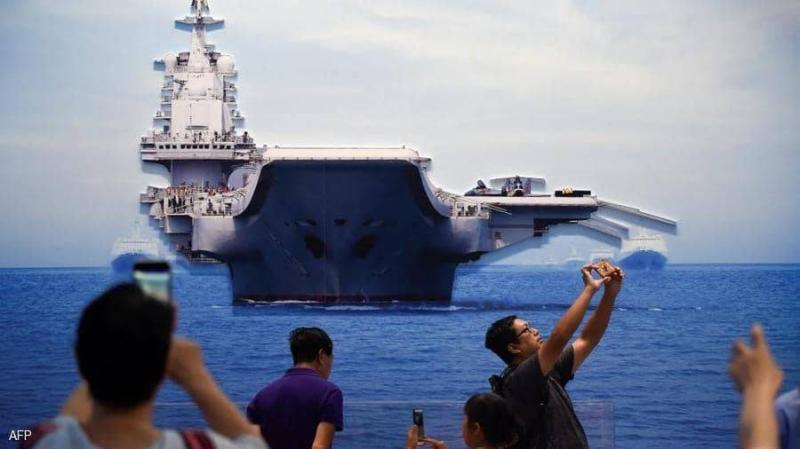Under the title "Electromagnetic Launch: A Chinese Aircraft Carrier with Extraordinary Capabilities," Sky News Arabia reported that many details about the new Chinese aircraft carrier "Type 003" remain unknown. Initial comparisons between it and the American models reveal various details about the size and strength of the third Chinese carrier, which represents an ambitious strategy adopted by Beijing to develop its forces and enhance its technologically advanced naval fleet.
In July 2019, China announced its national defense strategy aimed at strengthening its military and building a modern, technologically advanced army that relies on artificial intelligence. While the strategy emphasizes enhancing naval capabilities, and after successfully building its first domestically manufactured aircraft carrier that entered service in 2019, China plans to have six aircraft carriers by 2035. Currently, the Chinese navy operates two medium-sized aircraft carriers: Liaoning, which entered service in 2012, and Shandong, which entered service in 2019.
## Specifications of Type-003
China is constructing the new aircraft carrier (the third for the Chinese navy and the second fully domestically manufactured) in Shanghai, emphasizing its priorities to enhance naval abilities, in line with the global trend among major powers and in response to various threats. While the specifics of the new Chinese aircraft carrier remain mysterious, the military-focused site navalnews published a report based on data from the Shadowbreak Inti satellite, operated by Kompsat, detailing the preliminary specifications despite China's ongoing secrecy regarding official information.
According to the reported data, the anticipated length of the third Chinese aircraft carrier is 320 meters (only 5 meters longer than the second Chinese carrier Shandong, and 13 meters shorter than the famous American Ford-class carrier). Its width is approximately 73 meters (about the same as the width of the Shandong carrier at 75 meters). The report highlighted the most significant feature related to the aircraft launching system, which is "different from the previous two carriers." The Type-003 relies on electromagnetic launch technology through three platforms, following the American Ford-class carriers, instead of using steam catapults, leading to a faster launch rate. However, it is expected that China might face issues with this technology, as the United States has in the past.
Type-003 features two aircraft elevators on its right side, while the Ford has three elevators at the rear. The new model of Chinese aircraft carriers is described as "very close in size to American naval carriers," with the report indicating that it can be termed a super carrier. The report noted that the third aircraft carrier Type-003 will be very large, but there may be slight delays due to some design choices. At the same time, it points out that Beijing is rapidly gaining experience in constructing aircraft carriers and is investing well to succeed.
### Liaoning Carrier
Liaoning is the first aircraft carrier in China, entering service in 2012. It was built based on the Soviet cruiser (Varyag), which Beijing purchased from Ukraine in 1998. The carrier has a displacement of approximately 67,000 tons and can carry 50 aircraft. Liaoning is used for scientific research and military training and contributes to Beijing's development strategy. It possesses significant firepower and can operate without the need for other supporting ships, armed with anti-ship missiles in addition to cruise missiles.
### Shandong Carrier
The second aircraft carrier of the Chinese navy is Shandong, which entered service in December 2019 and was built in April 2017 at the Chinese Shipbuilding Industry Corporation in Dalian (northeast China). Shandong measures 315 meters in length, weighs about 50,000 tons, has a width of 75 meters, and a total displacement of 47,000 tons, with a 12-degree angled flight deck, and can carry 44 aircraft.
### Naval Forces
Despite the apparent superiority of the American Ford-class carrier and the overall numerical advantage of the United States in terms of aircraft carriers worldwide (10 carriers according to Global Fire Power data), analysts highlight a significant advancement and superiority of the Chinese navy at the expense of the United States. Commenting on the growing capabilities of the Chinese navy, former Pentagon official Michael Rubin stated that "the Chinese navy grows stronger every day, while the U.S. navy is declining in terms of equipment and readiness," highlighting the specific growth of Chinese naval capabilities.
Rubin believes that "China is more capable now than it was before" as Beijing seeks to challenge and compete with the United States militarily. However, he questions whether the Chinese populace is willing to endure continuous combat, considering the legacy of the one-child policy, as many families now have only one child to care for in old age. This raises the question of whether these families are prepared to lose their children in a potentially bloody and costly conflict, whether victory or loss is their fate.
Agreeing with Rubin, researcher at the New America Foundation Barak Barfi noted that in light of China's military strategy, the U.S. feels a real threat from this direction. He pointed out that "the U.S. sees China as an ascending threat, particularly regarding Beijing's superiority with a greater number of naval vessels than the U.S., along with China's significant advancements in shipbuilding."
The U.S. Navy currently operates 490 ships of various types, while China leads in the overall number of naval assets with 777 vessels. Barfi elaborated that this Chinese naval supremacy raises concerns within the U.S., especially given the competition and conflict between the two nations, asserting that Washington views Beijing as a more pressing threat than Russia, as reflected in the U.S. National Security Strategy document released earlier this March, particularly considering the strength of the Chinese economy and various factors at Beijing's disposal.
Barfi emphasizes that the growing Chinese military power is a source of concern for the U.S., especially as Beijing adopts a strategy for significantly developing its military capabilities in the coming years, with naval forces being a significant aspect of this plan, indicating a rise in Chinese strength in this regard.
### Chinese Military
The Chinese military is ranked third globally after the United States and Russia, with over 2.6 million personnel (2.1 million active and 510,000 reserves). Its budget is estimated to exceed $178 billion, according to Global Fire Power. The Chinese military operates 3,260 aircraft (1,200 combat aircraft, 371 attackers, 264 transport aircraft, 405 training planes, 115 special mission aircraft, and 902 military helicopters, of which 327 are attack helicopters, along with three tankers).
In terms of armored forces, the Chinese military possesses 3,205 tanks, 35,000 armored vehicles, 1,970 self-propelled guns, 1,234 field guns, and 2,250 rocket launchers, alongside 777 naval vessels, including two aircraft carriers currently in service.




